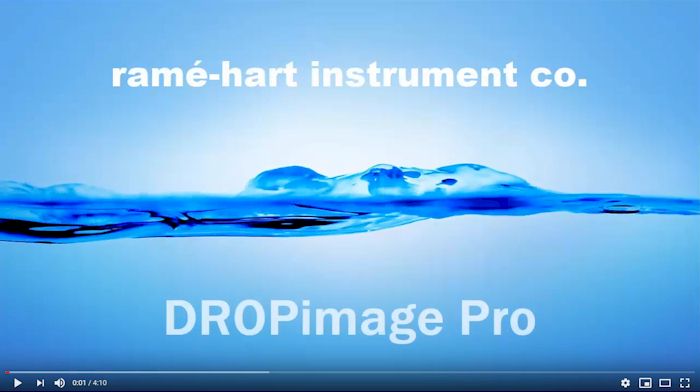|
April 2020 |
| Better Days are Coming |
|
One of the prior owners of ramé-hart
who has since retired used to always say, "Better days are coming."
It could be sunny and 70° F, the stock market could be up, and we'd
be heading into a three-day weekend and he'd still say it, "Better
days are coming." Perhaps those better days for him are those that
define a simpler life in Florida without the cares and stress of
being a small business owner. Nonetheless, now is a good time to say
it again and so let me do so: "Better days are coming."
Our thoughts are with each of you
and your family during this season of unprecedented disruption. As the Coronavirus
situation evolves, we want to assure you that we will continue to
support you to the maximum extent possible. We also have a business
contingency plan in place and, as needed, we have the capacity to
provide customer service and technical support from home locations.
Our team is giving thoughtful consideration to how we can safely
move forward. At this time, we want you to know that we continue to
accept and ship orders. We are also committed to communication and
continued excellent customer support. Please know that our hearts
and thoughts are with each of you and yours during this chapter of
uncertainty. Remember, better days are coming.
|
| Coronavirus and Contact Angle |
|
Who would have guessed just a few
months ago that COVID-19 would become a world-wide pandemic that
will profoundly affect our lives, our economies, and our way of life
in 2020? Nearly the entire world is aware of COVID-19.1
Whatever compelling statistics I have the urge to share with you, I
will refrain from doing so as those numbers will surely be
out-of-date by the time you read this.
Rather, our discussion today will focus on how contact angle is used to develop surfaces, materials, methods, and products that inhibit the spread of viruses such as COVID-19. But first, let's be clear about how the virus is spread. Flu strains including COVID-19 are primarily spread through airborne droplets that are ejected from an infected person while coughing or sneezing. However, spittle and nasal discharge too small to see can also settle on a surface and then be transmitted when a person touches the contaminated surface. One objective is to better understand how such a surface can be made antiviral in order to cut down on the spread of pathogens. One consideration is the actual anti-viral properties of materials. Researchers in England, for example, have discovered that influenza A particles cannot survive well on copper surfaces.2 Copper ions can disorder the RNA genome in the virus which can greatly curtail viral spread. This is critical since studies show that a finger that touches a virus-laden surface can then spread the virus to up to seven clean surfaces.3 That explains why schools, hospitals, airports, stadiums, and other high-traffic locations can be like Petri dishes for both viruses and bacteria alike. Researchers at MIT have discovered that hydrophobic polycationic coatings can effectively kill certain influenza viruses.4 Polyethylenimines which are hydrophobic polycations, for example, exhibit both antibicrobial as well as antiviral properties. These coatings have been found to be an effective coating for orthopedic hardware which not only supports bone healing but also arrests infection.4 Of course, a lot of work has been done to develop superhydrophobic anti-fouling materials. Myriad studies explore the special superficial surface attributes to find compelling features that address particular objectives - including antiviral and antibacterial capabilities. Researchers in Slovania, for instance, have proposed a sol-gel coating embedded with silver to produce fabric that is both omniphobic and antimicrobial and can retain the desired properties after being washed.6 Healthcare workers benefit from gowns and other personal protective equipment (PPE)7 that can prevent the transmission of diseases such as COVID-19 which can be spread through body fluids and blood. By adding a hydrophobic finish to these products, droplets of body fluid can easily roll off.8 Research has shown that as contact angle increases on PPE products, efficiency in reducing virus carryover also increases.9 Silica and PTFE nanoparticles have been used to produce superhydrophobic self-cleaning fabric that is chemically stable, washable, and potentially ideal for medical gowns and other PPE.10 Due to the unique nano- and micro-scale structures, an ultra low surface energy surface with low contact angle hysteresis and roll-off angles under 5° can be achieved. While novel materials and methods are a far cry from a cure for COVID-19, they will - along with safe practices - contribute to the protection of healthcare workers and others and help arrest the spread of pathogens. During this period of unprecedented challenges, we invite you to stay safe, practice good hygiene, and continue to hope for better days which do lie ahead around the next bend. Bullets
Notes 1 With the possible
exception of the
uncontacted people of
North Sentinel Island. |
| DROPimage Pro Software |
| A year ago we released our new DROPimage Pro software. This edition of DROPimage replaced DROPimage Standard but many new features were added - such as surface energy and surface tension capabilities. The video below illustrates the main features of DROPimage Pro which currently is shipping with Models 90 Pro Edition, 210, and 400. For more information on DROPimage Pro, visit this page. |
|
Regards,
Carl Clegg |

